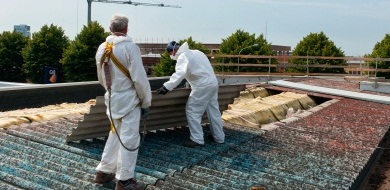Did you know that November is Asbestos Awareness Month? It’s a month dedicated to raising awareness about the prevalence of, and threat posed by, asbestos-containing materials.
Why? Because 1 in 3 Australian homes still contain asbestos and the consequences of exposure can be dire, included but not limited to mesothelioma – an aggressive form of lung cancer.
As Australia was one of the largest consumers of asbestos containing materials in the world, a lot of these materials can still be found in our homes today. Especially in Queensland the lack of buy-back or other government schemes to locate and remove asbestos have left many homes hiding asbestos-containing materials.
Unfortunately, we’re now experiencing what is commonly known as the ‘third wave’ of asbestos exposure – those who were exposed (or tragically, may be exposed to in the future) due to renovations of homes containing asbestos materials.
What are the three waves?
The three waves relate to the illnesses and deaths that have impacted so many, due to asbestos exposure and subsequent asbestos related diseases. The waves refer to the general way in which these individuals were exposed to these materials.
The first wave of illness hit those who mined or worked with the raw asbestos. The second wave of disease affected the factory employees, installers and others who worked directly with the asbestos containing materials. Tragically, it was not just those working directly with the asbestos materials who were affected and at risk. Husbands, wives and children were also often exposed – due to washing uniforms, or coming into regular contact with the individuals in their work clothing, still covered in these fibers.
Research unpacked by SBS late last year shows that the median income of carers is 42% lower than the income of non-carers, and a shockingly large number of carers live below the poverty line. This is also reflected in employment rates, with 56% of carers participating in the workforce, in contrast to 80% of non-carers.
The third wave is far reaching, as we now start to see the tragic result of all the renovations that took place across Australia in the 80’s and 90s and that are still continuing today. Tragically, research suggests that by 2030, asbestos-related diseases will have killed 60,000 Australians.
With house prices only increasing, the motivation to buy and self-renovate is high, and while information about the prevalence of asbestos materials is becoming more widely spread, there are still renovators every year who unknowingly expose themselves. In 2017 there was a 13% increase (on 2016) of the number of Australians who reported suspected asbestos exposure, which sadly indicates that expose is continuing, in spite of efforts to raise awareness of the asbestos materials still lurking in many homes.
What are the diseases linked to asbestos exposure?
Tragically, the consequences of exposure can be dire, with one of the worst diseases developed being mesothelioma. Mesothelioma is a rare and aggressive type of cancer which affects the lungs, it can take 20+ years to develop and horrifyingly the average life expectancy once diagnosed is only 12 months.
Other types of asbestos-related diseases include asbestosis, other firms of cancer and diseases affecting the pleural lining of the lung. Only some of the asbestos related conditions are malignant, and just because a person has come into contact with asbestos it does not necessarily mean that they will develop an asbestos-related disease.
Unfortunately, mesothelioma can have little rhyme or reason as to who eventually suffers from this form of cancer, with some individuals who had minimal exposure developing this and others who had continuous, long term exposure never developing it. In saying that, many of the conditions that can be developed due to exposure are still more likely to present in those who had higher exposure.
Thankfully, many individuals exposed to asbestos will never develop a related disease – exposure does not necessarily mean the development of a related condition.
Why is Asbestos Awareness Month so important?
With the reality of the statistics and diseases discussed above, the awareness month is a vital and important opportunity to continue to raise awareness about the harsh reality of asbestos exposure and why being cautious in all renovations is so important. It’s never worth risking it, or playing ‘renovation roulette’ as the month refers to it as.
Considering the age of a property and the likelihood of asbestos materials being present should be an important part of the purchasing process. Testing for this unfortunately isn’t a standard part of the checks and often is not conducted when purchasing, although it is possible and not too expensive. It could also very well save you a lot of money down the line on removal costs, or at the very least help guide your renovation plans.
If renovating your property (or a future property) is in the cards, getting these tests done is of the upmost importance – don’t risk your health or the health of those around you assisting with the renovations.














